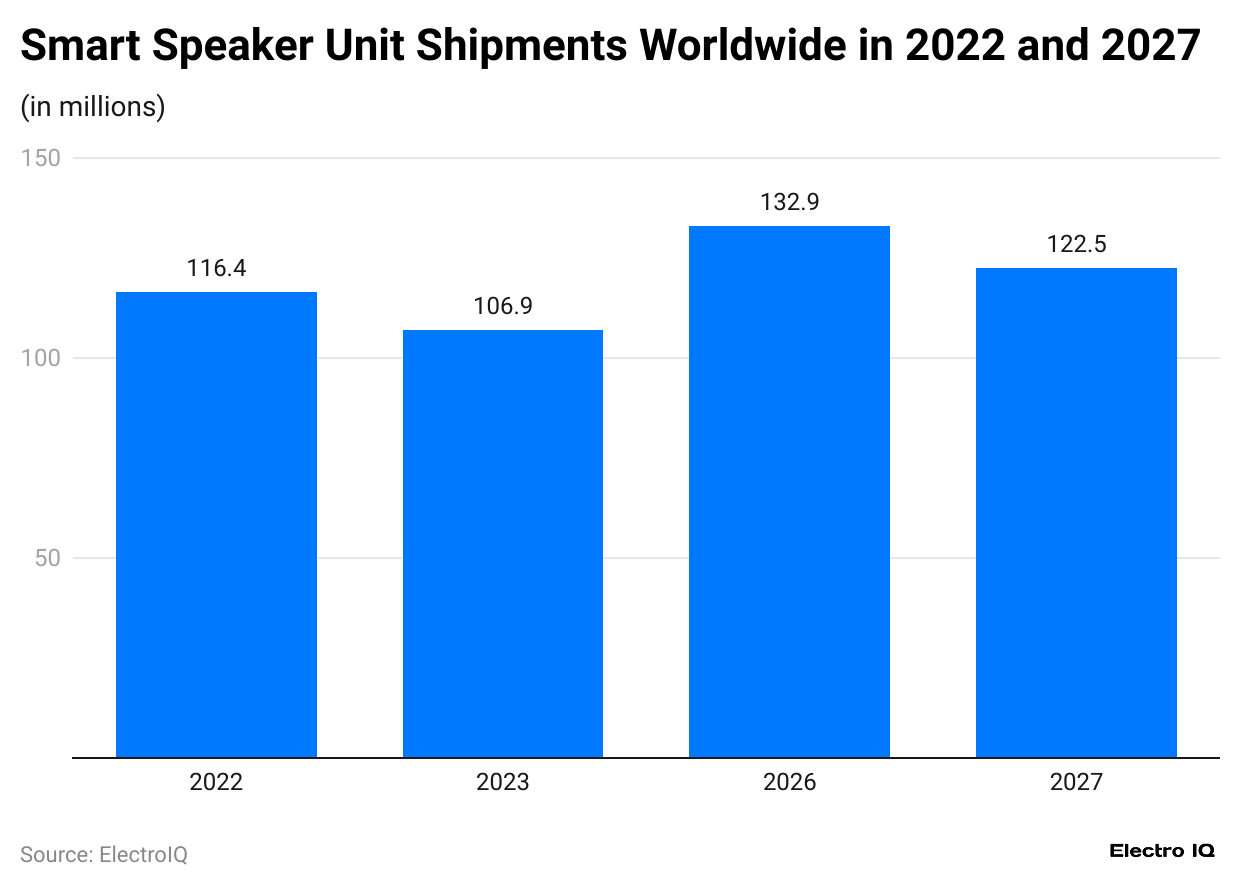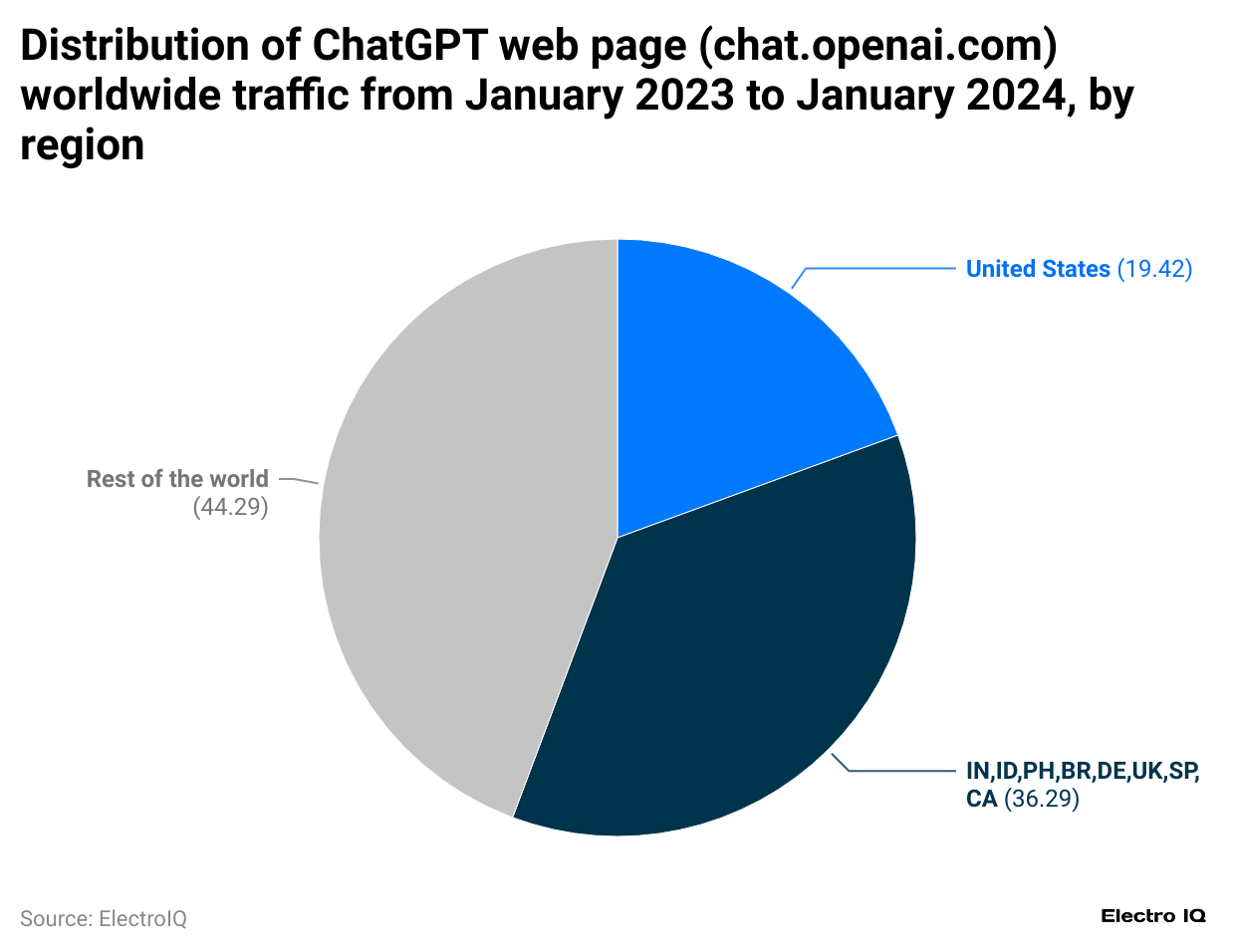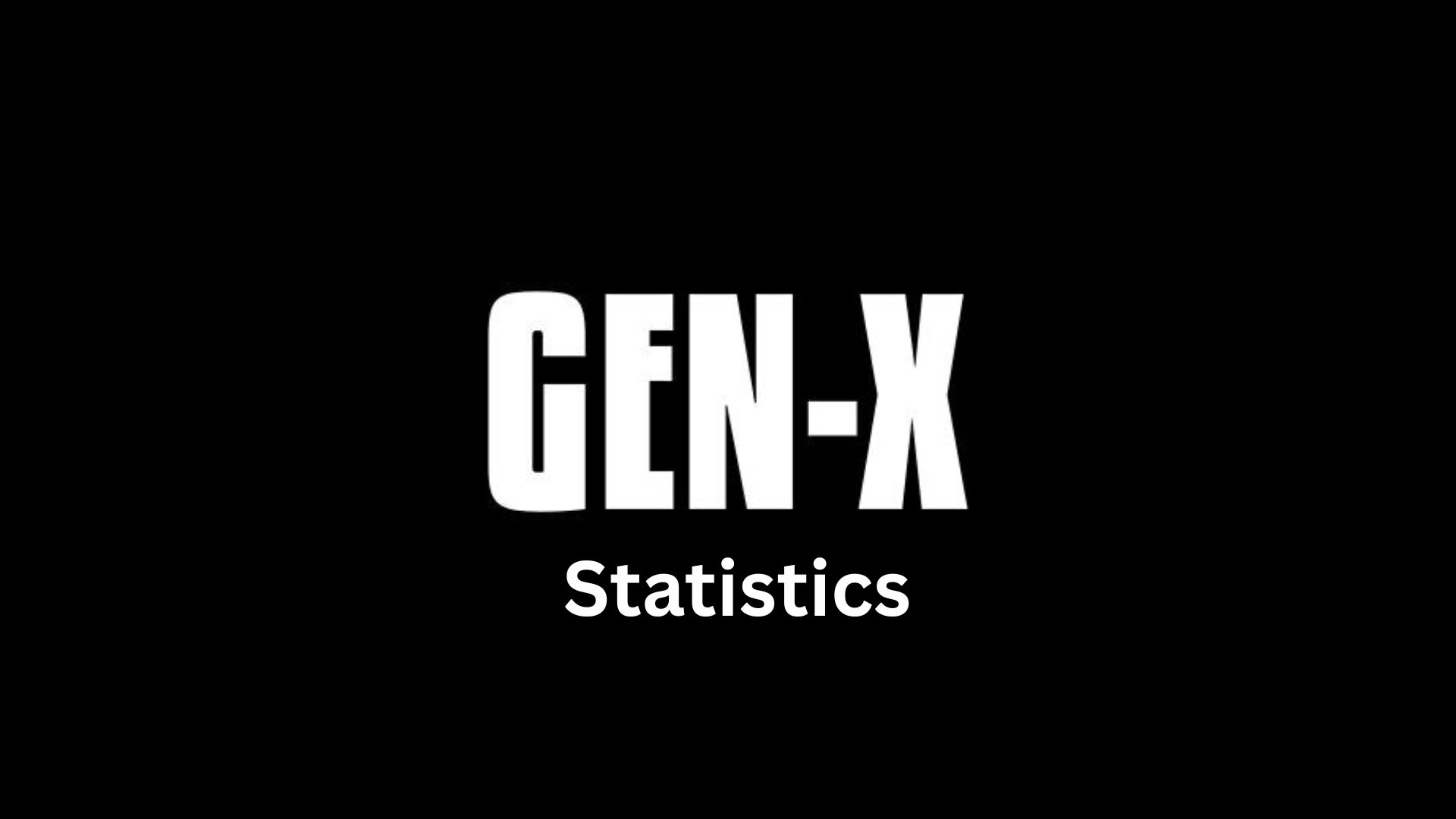Virtual Assistant Statistics By Market Size, Benefits, Industry and Facts
Updated · Nov 04, 2024

Table of Contents
- Introduction
- Editor’s Choice
- Benefits Of Hiring Virtual Assistants
- General Virtual Assistant Statistics
- Virtual Assistant Statistics by Industry
- Natural Language Processing Market Growth
- Speech Recognition Market Growth
- Virtual Assistant Salary Statistics
- Virtual Assistant Demographics
- Virtual Assistant Productivity Statistics
- Virtual Assistant Statistics for Career and Education
- Smart Speaker Unit Shipments Worldwide
- Popular Smart Speaker Brands By Country
- AI tool Usage For Research Purposes
- ChatGPT Traffic Distribution
- Different Chatbots Available
- Former Chatbots
- Conclusion
Introduction
Virtual Assistant Statistics: Virtual assistants are increasingly integrated into daily life, providing support for tasks like checking weather updates, ordering food, or playing music on command. Despite the technology once seeming futuristic, virtual assistants have become essential tools for many users. Apple’s Siri was among the first advanced virtual assistants to reach the public, sparking competition from other tech giants.
Google Assistant, Amazon Alexa, and Microsoft Cortana have since joined the market, each enhancing user experiences in distinct ways. Additionally, Chinese companies, including Alibaba, Baidu, and Xiaomi, have introduced their own products, with notable virtual assistants like Baidu DuerOS and Xiaomi Xiao AI gaining traction. Consumers frequently use these tools across various devices, from smart speakers to smartphones, as well as in their homes, cars, and workplaces.
The smart speaker market is closely tied to the growth of virtual assistants, with both sectors witnessing considerable adoption. Although smart speaker shipments saw a slight decline from 2022 to 2023, they are projected to rebound by 2026, signaling renewed interest in voice-activated technology. Meanwhile, generative AI is anticipated to transform virtual assistants, potentially enabling them to hold more sophisticated conversations and respond to complex queries that simpler systems struggle with.
Virtual assistants are also set to benefit from advancements in the Internet of Things (IoT), which connects devices in a network that facilitates communication between them. The global market for voice technology, a primary platform for virtual assistants, is expected to reach nearly USD 50 billion by 2029, driven by the ubiquity of smartphones and the rising popularity of smart speakers. In the United States alone, nearly 140 million people were already using voice assistants in 2022, underscoring the technology’s widespread adoption and growing role in modern life.
Editor’s Choice
- The Natural Language Processing (NLP) Market is expected to quintuple from USD 12.69 billion in 2020 to USD 63.37 billion by 2030.
- Smart Speaker Adoption in U.S. Households is expected to reach 65% by 2024.
- Smart Speaker Shipments dropped to 106.9 million units in 2023 but are projected to peak at 132.9 million units by 2026.
- Amazon Echo dominates the UK smart speaker market, holding a 72% market share.
- Google Home leads in the Netherlands and Sweden with a 40% market share.
- Speech Recognition saw a significant growth spike of 143.79% in 2021.
- ChatGPT’s Global Reach extends to 44.29% of traffic from regions outside major markets.
- The U.S. accounts for nearly 19.42% of all ChatGPT traffic.
- Half of Gen Z (50.2%) uses AI tools for purchase research.
- Young Adults (Ages 25-34) show a 49.1% likelihood of using AI tools for purchases.
- Businesses in the U.S. outsource at least one department, accounting for 66% of all companies.
- Businesses Save Up to 78% of Operating Costs by hiring virtual assistants compared to in-house employees.
- Cost Savings are cited by 59% of businesses as the primary reason for using outsourced workers.
- The Virtual Workforce in the U.S. is projected to reach 50% of the workforce by 2028.
- Outsourced Workers in the U.S. numbered over 2 million in the 2000s.
- 91% of Virtual Assistants (VAs) in the United States possess a college degree.
- Nearly 60% of VAs (59%) are working full-time roles.
- 60% of VAs have a college education, indicating a high level of professionalism and specialized expertise.
- 85% of VAs have their own websites, showcasing their skills and services professionally.
Benefits Of Hiring Virtual Assistants
- Save up to 78% in operating costs: Hiring full-time virtual assistants can help U.S. employers reduce annual operating costs by up to USD 78%.
- Boost productivity by 77%: Approximately 77% of remote workers report higher productivity compared to working in an office setting.
- Increase overall productivity by 13%: Productivity generally improves by at least 13% when employees work remotely.
- Reduce workload on in-house staff: Over 50% of tasks virtual assistants handle were previously completed by in-house employees.
- Lower absenteeism: Virtual assistants, on average, take fewer sick days than local hires, leading to more consistent productivity.
- Lower overhead expenses: Since virtual assistants work remotely, they can help companies save on overhead costs, such as office space and utilities.
General Virtual Assistant Statistics
- The global virtual assistant workforce varies greatly, estimated between 25,000 and 30+ million depending on definitions. If “virtual assistant” includes all remote freelancers, the number reaches tens of millions, with 12 million freelancers on Upwork, 20 million on Freelancer, and 3 million on Fiverr.
- Philippines holds the largest percentage of the world’s virtual assistants, with 13% of virtual assistants on Upwork originating there.
- In 2020, the hiring of offshore virtual assistants through agencies increased by 41%, largely due to businesses closing offices and the rise of remote work during the pandemic.
- In 2020, freelance virtual assistants saw a 16% increase in bookings on online marketplaces, driven by the demand for remote work expertise during the pandemic.
- Virtual assistants can save 78% on operating costs compared to full-time, on-site employees. The savings come from reduced expenses on office space, equipment, and benefits.
- Virtual assistants are generally affordable, with hourly rates ranging from USD 2 to USD 20 globally. In the U.S., they average USD 24 per hour, while in the Philippines, rates are USD 14-16 per hour.
- 87% of virtual assistants work on an hourly wage basis. Payment depends on the type of employment—freelancers receive direct payments, while agency or managed service hires involve paying the agency or service provider.
- 59% of virtual assistants work full-time, often supporting multiple clients, turning part-time roles into a full-time workload.
- 60% of virtual assistants hold a college degree. In countries like the Philippines, virtual assistant roles are attractive due to competitive pay and job satisfaction compared to local job options.
- 83-90% of virtual assistants are women. Public media often portray women as better multitaskers, influencing gender representation in the industry.
- In the United States, over 150,000 virtual assistant jobs are available on platforms like Ziprecruiter.com, indicating substantial demand for this role.
- Virtual assistants cost 78% less than in-house employees due to lower overheads, making them an attractive option for both small businesses and large corporations.
- The average age of a virtual assistant in the U.S. is 40, aligning with the preference of executives for experienced and trustworthy professionals.
- 85% of virtual assistants have professional websites, showing their commitment to building and marketing their services.
- In 2023, 35% of high-earning executives used a virtual assistant, and 28% in 2024, highlighting a steady demand in executive circles.
- Executives spend around 16 hours per week on administrative tasks, such as scheduling, emailing, and trip planning. Virtual assistants help reduce this time, enabling executives to focus on core responsibilities.
- The term “virtual assistant” was first coined in 1996. Initially, secretarial roles were male-dominated, but the rise of typing and remote work led to the popularization of virtual assistant roles.
- The Philippines is a leading source of virtual assistants globally, with a 96% literacy rate, high education standards, and proficiency in business English, making it a preferred outsourcing destination.
- In 2018, one-third of small business owners outsourced to virtual assistants, showing the cost-effectiveness and accessibility of these services to businesses of all sizes.
Virtual Assistant Statistics by Industry
- The largest share of virtual assistants work in the tech industry.
- 50% of the RealTrends™ Top 10 Real Estate Teams, recognized as highly rated professionals, have utilized virtual assistants sourced through MyOutDesk.
- 30.9% of virtual assistants hold business degrees, making them versatile across various industries.
- The industries that most frequently outsource work are Information Technology (IT), Finance/Accounting, and Healthcare.
- Customer service remains the most common task assigned to virtual assistants.
- The most frequent previous job for virtual assistants is an administrative assistant position.
- 24% of small businesses outsource to enhance efficiency in their operations.
Natural Language Processing Market Growth

(Reference: statista.com)
- Virtual Assistant Statistics show the growth of the natural language processing (NLP) market worldwide from 2020 to 2030. The billions of U.S. dollar data indicate a strong upward trend, with significant growth expected across the decade.
- In 2020, the NLP market size was approximately $12.69 billion, marking the start of a rapid expansion phase, with market size increasing to $23.68 billion by the end of 2023.
- By 2024, the market size is expected to more than double from 2021, reaching $34.71 billion, showing accelerated growth. It is predicted the market to reach $63.37 billion by 2030,
Speech Recognition Market Growth
(Reference: statista.com)
- Virtual Assistant Statistics show the growth trajectory of the speech recognition segment within the computer vision market globally from 2021 to 2030.
- The speech recognition segment experienced a massive surge in 2021, with a growth rate of 143.79%, marking a notable market segment expansion. Following the 2021 surge, the market saw a sharp decline in 2022, with a growth rate of -26.85%, indicating a market correction after the initial boom. The market bounced back in 2023 with 17.49% growth.
- By 2030, the growth rate is expected to grow 12.82%, indicating a sustained but modest expansion in the future.
Virtual Assistant Salary Statistics
- 87% of virtual assistants are paid hourly.
- The average yearly salary for a virtual assistant in the United States is USD 50,749.
- Virtual assistants in the U.S. with 1 to 3 years of experience earn an average of USD 49,718 per year.
- Those with over 15 years of experience earn an average of USD 60,291 per year.
- The average hourly rate for an American virtual assistant is USD 24/hr.
Virtual Assistant Demographics
- Women represent 87% of virtual assistants in the United States.
- The number of male virtual assistants in the U.S. has increased by 44% since 2010.
- Most American virtual assistants are over 40 years old.
- 66.5% of virtual assistants in the United States are White.
- Hispanic and Black virtual assistants collectively make up over 25% of the U.S. virtual assistant workforce.
Virtual Assistant Productivity Statistics
- Virtual assistants can enhance workforce productivity by up to 35%.
- Virtual assistants have the potential to improve workforce efficiency by 35%.
- 85% of virtual workers reported feeling more productive when working from home. (Source: IWG)
- 13% of employees are more productive when working from home. (Source: Virtudesk)
- On average, companies save 22 minutes of time each day by utilizing virtual assistants.
- Over 20% of virtual assistant users delegate calendar management tasks.
- 92% of virtual assistants report high satisfaction with the flexibility of their work.
- Virtual assistants typically work around 20 hours per week, given their flexible schedules.
Virtual Assistant Statistics for Career and Education
- Data entry is the most common skill found on virtual assistant resumes, appearing in 9.3% of samples. The second most common hard skill is customer service, which is present on 7.8% of resumes. Email management ranks third among virtual assistant skills, featured on 7.6% of resumes.
- The three most common soft skills for virtual assistants are interpersonal skills, organizational abilities, and writing proficiency.
- On average, a virtual assistant resume is 412 words long and spans 0.9 pages, based on an average of 450 words per page. The most frequently held degree among virtual assistants is a bachelor’s degree, with 54% of individuals having this level of education. An associate degree is the second most common education level, held by 22%, followed by a high school diploma at 9%. Nearly 45% of virtual assistants possess a bachelor’s degree.
- The Philippines and India are popular recruitment hubs for virtual assistants, with cost-effective plans starting from USD 400 per month, which appeals to many Americans. In the United States, experienced virtual assistants can earn over USD 4,000 per month.
- 41% of users report that the biggest challenge in hiring a virtual assistant is finding someone trustworthy and reliable. Additionally, a majority of 59% of virtual assistants are engaged in full-time employment.
Smart Speaker Unit Shipments Worldwide

(Reference: statista.com)
- Virtual Assistant Statistics show an overall upward trend, despite a dip in 2023, and predicted stabilization by the end of
- In 2022, smart speaker unit shipments reached 116.4 million, indicating a solid demand for these devices. Shipments dropped to 106.9 million in 2023, suggesting a temporary decrease in demand or market adjustment.
- By 2026, shipments are predicted to reach their highest point at 132.9 million, representing a significant rebound and expansion in the smart speaker market. After the peak in 2026, shipments are expected to slightly decrease to 122.5 million in 2027, indicating market stabilization.
Popular Smart Speaker Brands By Country

(Reference: statista.com)
- Virtual Assistant Statistics show that Amazon Echo is dominant in most regions while also showcasing regional variations in brand preference.
- 72% of smart speaker owners in the UK use Amazon Echo, the highest share among the listed countries. Also, in Germany (71%), Brazil (68%), the United States (65%), and India (63%), Amazon Echo is the leading smart speaker brand, demonstrating its strong global market presence.
- In contrast to Amazon’s dominance elsewhere, Google Home is the most owned brand in the Netherlands (40%) and Sweden (40%), reflecting regional preferences for different ecosystems.
- KT is the most owned smart speaker brand in South Korea, with 27% of the market, indicating a local brand preference in this market.
AI tool Usage For Research Purposes

(Reference: statista.com)
- Virtual Assistant Statistics show that younger generations are more likely to adopt AI tools for purchase research than older age groups.
- The 18-24 age group is the most likely to use AI tools like ChatGPT for purchase research, with 50.2% of respondents showing a positive inclination. In the 25-34 age group, 49.1% of respondents are likely to use AI tools for purchase research, which is very close to the younger cohort and indicates strong adoption among young adults.
- The 35-44 age group shows a slightly lower but still significant likelihood, with 43.7% of respondents indicating they would use AI tools like ChatGPT.The likelihood drops to 38% among those aged 45-54 and even further to 28.2% for the 55-64 age group, reflecting a clear generational gap in AI tool adoption.
ChatGPT Traffic Distribution

(Reference: statista.com)
- Virtual Assistant Statistics show that the largest traffic sources, the United States and a collective group of other key countries, generate most of the visits. At the same time, the remaining parts of the world also contribute a significant share.
- The United States accounted for 42% of worldwide traffic to the ChatGPT website, making it the largest traffic source.
- A collective group of countries, including India, Indonesia, the Philippines, Brazil, Germany, the United Kingdom, Spain, and Canada, contributed 29% of the total traffic. These regions represent a substantial portion of ChatGPT’s global user base.
- The Rest of the World (regions outside the specified countries) made up the largest share of traffic, contributing 29%, indicating widespread global use of ChatGPT.
Different Chatbots Available
| Chatbot | Developer | Released | Platform | Technology |
| Leo | Brave Software | 11/2/2023 | Windows, macOS, Linux | LLaMA 2, Claude |
| Assistant | 5/18/2016 | Android, ChromeOS, iOS, iPadOS, KaiOS, Linux, Android TV, Wear OS | – | |
| Ultra Hal | Robert Medeksza | 12/4/2000 | Windows | GPT-3 |
| CarynAI | Caryn Marjorie | 5/9/2023 | – | BanterAI |
| Q | Amazon | 11/28/2023 | Web app | Amazon Titan, Amazon Bedrock, GPT |
| Celia | Huawei | 4/27/2020 | Android, EMUI, HarmonyOS | Huawei PanGu |
| Ernie Bot | Baidu | 3/16/2023 | – | – |
| MegaHAL | Jason Hutchens | 4/30/1995 | Web app, command line | – |
| Alexa | Amazon | 11/6/2014 | Fire OS, iOS, Android, Linux, Windows, Wear OS | Polish speech synthesizer Ivona |
| Clova | Naver Corporation | 3/1/2017 | iOS, Android | – |
| Gemini | 3/21/2023 | Web app, Android, iOS | Gemini (language model) | |
| GigaChat | Sberbank | 2023-04 | Web app | – |
| Alice | Yandex | 10/10/2017 | Windows, iOS, Android | YandexGPT |
| Claude | Anthropic | 2023-03 | Web app, iOS | Claude 2.1 |
| Braina | Brainasoft | 2/9/2014 | Windows | Various |
| SimSimi | ISMaker | 2002 | Web app, iOS, Android | – |
| Kuki | Steve Worswick | 2013 | Weappspp, social networks | Pandorabots AIML |
| Lenny | “Mango” | 2011 | – | Source-available |
| Bixby | Samsung Electronics | 4/21/2017 | Android, Tizen, Windows, Wear OS | Proprietary, open-source components |
| Grok | xAI | 11/4/2023 | Web app | Proprietary, Apache-2.0 (Grok-1) |
| SpookiTalk | The Digital Village | 4/2/1998 | Windows, Classic Mac OS | VelociText |
| Jabberwockyy | Rollo Carpenter | 1997 | Web app | – |
| ChatGPT | OpenAI | 11/30/2022 | Web app, iOS, Android | GPT-4, GPT-4o, GPT-4o mini |
| SILVIA | Cognitive Code | 1/1/2008 | Windows, macOS, iOS, Android | – |
| Siri | Apple Inc. | 10/5/2011 | iOS, iPadOS, watchOS, macOS, tvOS, audioOS | – |
| Cleverbot | Rollo Carpenter | 2008-10 | Web app | – |
| AliGenie | Alibaba Group | 7/5/2017 | – | – |
| Copilot | Microsoft | 2/7/2023 | Web app, Windows, iOS, Android | Microsoft Prometheus, GPT-4 |
(Source: wikipedia.org)
Former Chatbots
| Chatbot | Developer | Released | Discontinued | Platform | Technology |
| Tay | Microsoft | 3/23/2016 | 3/24/2016 | – | |
| GooglyMinotaur | ActiveBuddy | 2001-06 | 3/24/2002 | AIM | – |
| Sparrow | Google DeepMind | 2022-09 | 1/12/2023 | Web app | Chinchilla |
| PARRY | Kenneth Colby | 1972 | – | – | – |
| Evi | True Knowledge | 2012-10 | 1/23/2014 | iOS, Android | – |
| Eugene Goostman | Vladimir Veselov, Eugene Demchenko, Sergey Ulasen | 2001 | 6/7/2014 | – | – |
| SmarterChild | ActiveBuddy | 2001-06 | 10/12/2006 | AIM, Windows Live Messenger | – |
| Albert One | Robby Garner | 1995 | – | The Internet | Multi-faceted approach in natural-language programming |
| Artificial Linguistic Internet Computer Entity | Richard Wallace | 11/23/1995 | 10/15/2013 | – | AIMSL |
| Assistant | Speaktoit | 3/1/2011 | 12/15/2016 | Android, iOS, Windows Phone, Windows 8, Windows 10, ChromeOS | – |
| Dr. Sbaitso | Creative Labs | 1991-06 | – | MS-DOS | Speech synthesis |
| Mycroft | Mycroft team | 11/17/2015 | 1/31/2023 | Linux | – |
| Mark V Shaney | Rob Pike, Bruce Ellis, Don P. Mitchell | 1981 | – | Usenet | Markov chain techniques |
| Racerr | Mindscape | 1984 | – | IBM PC compatibles, Apple II, Mac, Amiga | – |
| Jeepneyy AI | C.J. Jones | 2007-02 | 2010 | – | – |
| ELIZA | Joseph Weizenbaum | 1964 | 1967 | – | Pattern matching, MAD-SLIP, lisp-like representation |
| Charliex | – | 4/17/2006 | 3/3/2010 | Linux | Based on Artificial Linguistic Internet Computer Entity |
| Infobot | Kevin Lenzo | 1995-06 | – | IRC | Perl, factoids |
| Fred | Robby Garner | 12/1/1997 | – | – | – |
| Verbot | Avaya | 1997 | 2012 | Microsoft Windows, web app | – |
| Viv | Viv Labs, Inc. | 5/9/2016 | 10/18/2017 | iOS, Android | Integrated into Bixby 2.0 |
| Cortana | Microsoft | 4/2/2014 | 8/11/2023 | Windows, Windows Phone, iOS, Android, Xbox OS | Tellme Networks, Satori, Microsoft Eva |
(Source: wikipedia.org)
Conclusion
The virtual assistant market is pivotal in transformation, with statistics indicating a trajectory of substantial growth and increasing sophistication. Virtual Assistant Statistics show widespread adoption across different sectors, from consumer applications to enterprise solutions.
Key trends emerge from these statistics: the significant growth in the NLP market, the dominance of certain players in the smart speaker space, and the increasing acceptance of AI-powered tools across different age groups. In conclusion, their virtual assistants have transformed how we interact with technology and conduct business.
Sources
FAQ.
The NLP market is predicted to reach $63.37 billion by 2030, up significantly from $12.69 billion in 2020.
The United States leads 19.42% of worldwide traffic to the ChatGPT website.
The 18-24 age group is most likely, with 50.2% of users in this range using AI tools like ChatGPT for purchase research.
Amazon Echo leads in global smart speaker markets, especially in the UK (72%), Germany (71%), and Brazil (68%).
The speech recognition market grew by 17.49% in 2023, rebounding after a decline in 2022.
Smart speaker shipments are projected to reach 122.5 million units by 2027.
The virtual assistant market is expected to grow at a CAGR of 18.5% between 2023 and 2028.
In 2023, over 57% of US households utilized smart speakers with virtual assistant functionality.
OpenAI launched ChatGPT on November 30, 2022.
In 2023, the global virtual assistant market was valued at approximately US$9.6 billion.

Maitrayee Dey has a background in Electrical Engineering and has worked in various technical roles before transitioning to writing. Specializing in technology and Artificial Intelligence, she has served as an Academic Research Analyst and Freelance Writer, particularly focusing on education and healthcare in Australia. Maitrayee's lifelong passions for writing and painting led her to pursue a full-time writing career. She is also the creator of a cooking YouTube channel, where she shares her culinary adventures. At Smartphone Thoughts, Maitrayee brings her expertise in technology to provide in-depth smartphone reviews and app-related statistics, making complex topics easy to understand for all readers.











